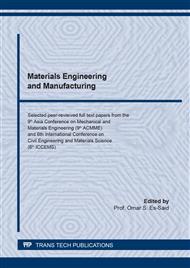[1]
Tran Thi Hong, Nguyen Van Cuong, Le Hong Ky, Nguyen Quoc Tuan, Banh Tien Long, Luu Anh Tung, Nguyen Thanh Tu and Vu Ngoc Pi, Multi-Criteria Optimization of Dressing Parameters for Surface Grinding 90CrSi Tool Steel Using Taguchi Method and Grey Relational Analysis,, Material Science and Engineering Technology VIII, pp.61-68 (2020).
DOI: 10.4028/www.scientific.net/msf.998.61
Google Scholar
[2]
Tran Thi Hong et al., Effect of Dressing Parameters on Material Removal Rate when Surface Grinding SKD11 Tool Steel,, Materials Science Forum Vol. 1020, pp.60-67 (2021).
DOI: 10.4028/www.scientific.net/msf.1020.60
Google Scholar
[3]
Tran Thi Hong et al., Optimization of Dressing Parameters in Surface Grinding SKD11 Tool Steel by Using Taguchi Method,, ICERA 2020, LNNS 178, p.636–647, (2021).
Google Scholar
[4]
Tran Thi Hong et al., Luu Anh Tung, "Optimizing Dressing Conditions for Minimum Flatness Tolerance when Grinding SKD11 Tool Steel, Structural and Smart Materials IV, pp.83-90, (2021).
DOI: 10.4028/www.scientific.net/msf.1020.83
Google Scholar
[5]
Jack Palmer, Hassan Ghadbeigi, Donka Novovic, David Curtis An experimental study of the effects of dressing parameters on the topography of grinding wheels during roller dressing,, Journal of Manufacturing Processes (2017).
DOI: 10.1016/j.jmapro.2017.11.025
Google Scholar
[6]
Z. PRUSAK, J. A. WEBSTER and I. D. MARINESCU, Influence of dressing parameters on grinding performance of CBN/Seeded Gel hybrid wheels in cylindrical grinding,, int. j. prod. res., vol. 35, no. 10, pp.2989-2915 (1997).
DOI: 10.1080/002075497194507
Google Scholar
[7]
Xun Chen, W. Brian Rowe, D. R. Allanson, B. Mills, A Grinding Power Model for Selection of Dressing and Grinding Conditions,, Journal of Manufacturing Science and Engineering, Vol. 121, pp.632-637, (1999).
DOI: 10.1115/1.2833084
Google Scholar
[8]
A. Daneshia, N. Jandaghia, T. Tawakolia, Effect of Dressing on Internal Cylindrical Grinding,, the International Scientific Committee of the 6th CIRP International Conference on High Performance Cutting, pp.37-41 (2014).
Google Scholar
[9]
J. Kundrák, V. Fedorovich, A.P. Markopoulos, I. Pyzhov, Improvements of the Dressing Process of Super Abrasive Diamond Grinding Wheels,, Manufacturing Technology (2014).
DOI: 10.21062/ujep/x.2014/a/1213-2489/mt/14/4/545
Google Scholar
[10]
ALEKSANDROVA Irina, Optimization of the Dressing Parameters in Cylindrical Grinding Based on a Generalized Utility Function,, CHINESE JOURNAL OF MECHANICAL ENGINEERING, Vol. 29, No. 1, pp.63-73 (2016).
DOI: 10.3901/cjme.2015.1103.130
Google Scholar
[11]
Haoyang Cao, Xun Chen and Haolin Li, Dressing strategy and grinding control for cylindrical microstructural surface,, The International Journal of Advanced Manufacturing Technology, Vol. 99, p.707–727, (2018).
DOI: 10.1007/s00170-018-2466-z
Google Scholar
[12]
Le Phuong Thao, Tran Thi Hong, Nguyen Thi Thanh Nga, Do Duc Trung, Jun Gong and Vu Ngoc Pi, Influence of dressing parameters on surface roughness of workpiece for grinding hardened 9XC tool steel,, IOP Conf. Series: Materials Science and Engineering 542 (2019).
DOI: 10.1088/1757-899x/542/1/012008
Google Scholar
[13]
C. N. de Souza and R. E. Catai, P. R. de Aguiar, M. H. Salgado, E. C. Bianchi, Analysis of Diametrical Wear of Grinding Wheel and Roundness Errors in the Machining of Steel VC 131,, J. of the Braz. Soc. of Mech. Sci. & Eng, Vol. XXVI, No. 2, pp.209-212 (2004).
DOI: 10.1590/s1678-58782004000200013
Google Scholar
[14]
H. SAGLAM, F. UNSACAR and S. YALDIZ, An experimental investigation as to the effect of cutting parameters on roundness error and surface roughness in cylindrical grinding,, International Journal of Production Research, Vol. 43, No. 11, p.2309–2322 (2005).
DOI: 10.1080/00207540412331330110
Google Scholar
[15]
Tran Thi Hong, Nguyen Anh Tuan, Bui Thanh Danh, Le Hong Ky, Nguyen Hong Linh, Tran Ngoc Giang, and Vu Ngoc Pi, Nguyen Manh Cuong, Evaluating Influences of Input Parameters on Surface Roughness in Sinking EDM Cylindrical Shaped Parts,, Metal Materials Processes and Manufacturing, Vol. 1018, pp.85-90 (2021).
DOI: 10.4028/www.scientific.net/msf.1018.85
Google Scholar


